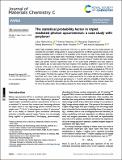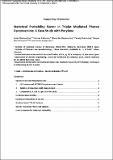Por favor, use este identificador para citar o enlazar a este item:
http://hdl.handle.net/10261/341520COMPARTIR / EXPORTAR:
 SHARE SHARE
 CORE
BASE CORE
BASE
|
|
| Visualizar otros formatos: MARC | Dublin Core | RDF | ORE | MODS | METS | DIDL | DATACITE | |

| Título: | The statistical probability factor in triplet mediated photon upconversion: a case study with perylene |
Autor: | Naimovičius, Lukas; Radiunas, Edvinas; Dapkevičius, Manvydas; Bharmoria, Pankaj; Moth-Poulsen, Kasper; Kazlauskas, Karolis | Palabras clave: | State energy Fluid solutions Nanocapsules |
Fecha de publicación: | 2-nov-2023 | Editor: | Royal Society of Chemistry (UK) | Citación: | Journal of Materials Chemistry. C, Materials for optical and electronic devices 11(42): 14826-14832 (2023) | Resumen: | Triplet-triplet annihilation photon upconversion (TTA-UC) is a process where two low-energy photons are converted into one higher-energy photon. A crucial component for an efficient upconversion process is the statistical probability factor (f), defined as the probability of the formation of a high-energy singlet state upon coupling of two low-energy triplet states. Theoretically, f depends on the energy level distribution, molecular orientation, inter-triplet exchange coupling of triplet dyads, and spin-mixing of resulting spin states (singlet, triplet, and quintet). However, experimental values of f for acene-based annihilators have been subject to large variations due to many factors that have resulted in the reporting of different f values for the same molecule. In this work, we discuss these factors by studying perylene as a case study annihilator, for which by far the largest variation in f = 16 to 100% has been reported. We systematically investigated the TTA-UC of PdTPBP:perylene, as a sensitizer-annihilator pair and obtained the experimental f = 17.9 ± 2.1% for perylene in THF solution. This limits the maximum TTA-UC quantum yield to 9.0% (out of 50%) for this annihilator. We found that such a low f value for perylene is largely governed by the energy-gap law where higher non-radiative losses due to the small energy gap between 2 × T1 and T2 affect the probability of singlet formation. Interestingly, we found this observation true for other acene-based annihilators whose emission ranges from the UV to the yellow region, thus providing a blueprint for future design of efficient TTA-UC systems. | Versión del editor: | http://doi.org/10.1039/d3tc03158f | URI: | http://hdl.handle.net/10261/341520 | DOI: | 10.1039/d3tc03158f | ISSN: | 2050-7526 |
| Aparece en las colecciones: | (ICMAB) Artículos |
Ficheros en este ítem:
| Fichero | Descripción | Tamaño | Formato | |
|---|---|---|---|---|
| Naimovicius_JMatChemC_2023_editorial.pdf | Artículo principal | 1,19 MB | Adobe PDF |  Visualizar/Abrir |
| Naimovicius_JMatChemC_2023_suppl_editorial.pdf | Información complementaria | 546,56 kB | Adobe PDF |  Visualizar/Abrir |
CORE Recommender
SCOPUSTM
Citations
2
checked on 28-abr-2024
Page view(s)
25
checked on 01-may-2024
Download(s)
23
checked on 01-may-2024
Google ScholarTM
Check
Altmetric
Altmetric
Este item está licenciado bajo una Licencia Creative Commons

